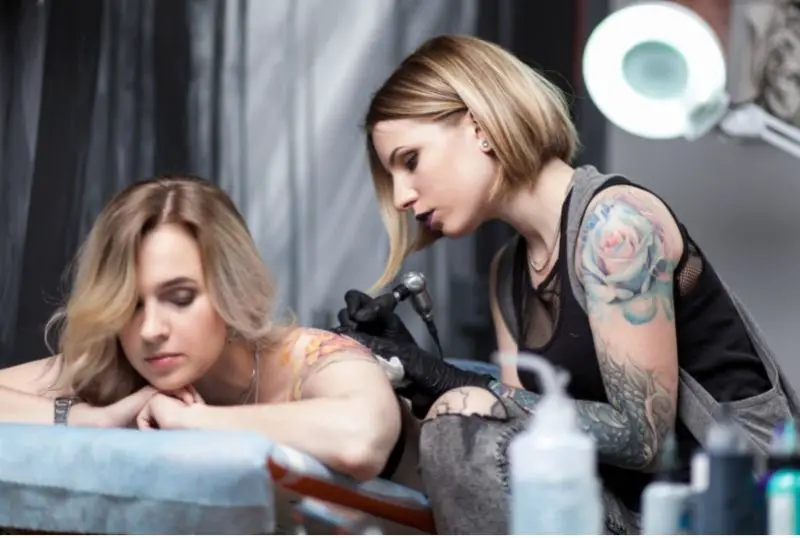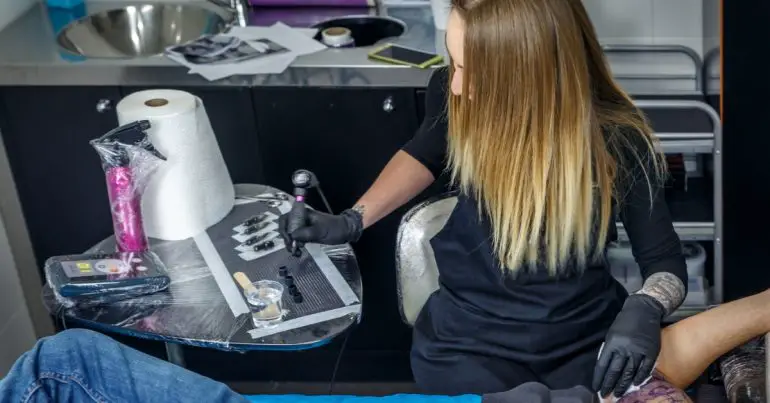How to Become a Tattoo Artist? A Simple Guide You Can Follow.
Being a tattoo artist isn’t an instant process.
Having good drawing skills doesn’t guarantee you to become a tattoo artist, but they are a major requirement needed by every professional tattoo artist.
So, how to become a Tattoo Artist?
First things first, you must understand the job description and responsibilities.
It’s also important to know what steps to take. You can’t just think of opening a tattoo shop without having knowledge of licensing, regulations, etc.
Running a tattoo shop isn’t different from running any other business.
You must comply with the regulations and requirements, such as maintaining high standards of hygiene, using quality equipment, and taking safety precautions.
Depending on where you live, it’s probably not mandatory to have a degree to become a tattoo artist, but you still have to take it seriously regardless.
Tattooing can be a risky procedure when not done correctly.
So as not to put your clients’ health at risk, know the guidelines of becoming a professional tattoo artist.
Attain the Required Skills
There are a few basic skills that you need to have, one of which is artistic skills.
Not everyone is born as a talented drawer, but many gain this ability through practice.
Don’t be discouraged if you’re not good at drawing because you can develop it by taking classes and practicing a lot.
Some people are lucky, though, because they are born with a natural talent.
It doesn’t take long for them to learn how to create intricate designs.
However, it’s worth-noting that as a tattoo artist, designs come from clients.
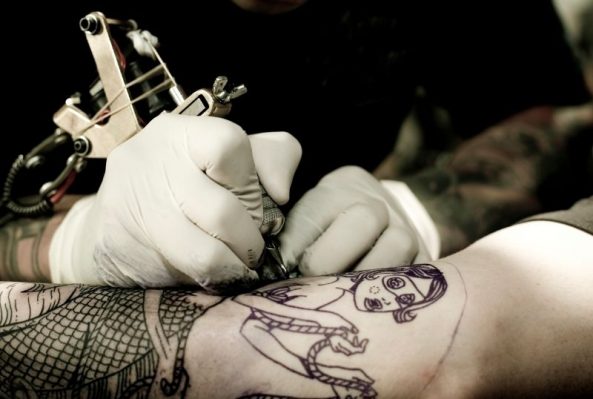
Some probably already have their designs ready, while others come up with ideas that you have to visualize, turn into a design, and draw out on paper.
Besides drawing skills, health skills are second most important.
Tattooing is supposed to sterile.
Poor hygiene can lead to infection and put clients’ health at risk.
Safety practices should start by using sterile supplies.
Tattoo machines, needles, and other components should be cleaned before you do a tattoo.
You’ll also need to wear safety gloves to lower the risk of contamination.
Basically, there are a lot of practices you should follow to ensure that a procedure doesn’t pose health risks.
Since tattooing is done on the skin, it’s paramount to study the anatomy of the skin, the layers it has, where ink stays following injection, allergic reactions, wound healing, infection control, etc.
Get Proper Education
Tattooing is a craft with a rich history that’s not only expressed in the designs, but also in the lives of the artists who create them.
Traditionally, tattoo artists learned the trade through apprenticeships, but in recent years, formal education has become a popular option for aspiring artists.
Graduate with High School Diploma
This will be useful when you’re trying to get a tattoo license because in many places, applicants are required to grade from high school.
Well, it’s a basic requirement if you want to apply for any job.
High-paying jobs usually require higher levels of education, so consider yourself lucky if you want to pursue a career as a tattoo artist because it’s less demanding in terms of education requirements.
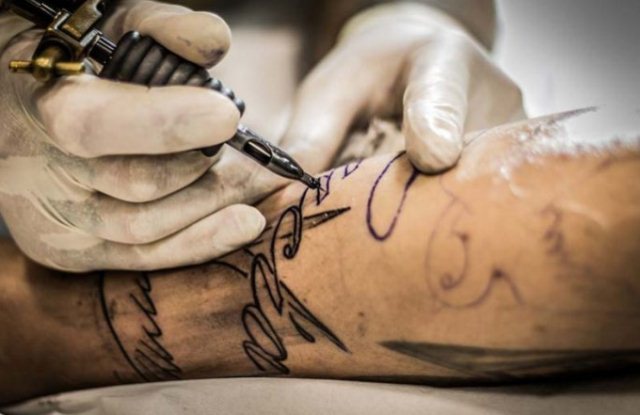
Complete an Apprenticeship
For your information, becoming a tattoo artist doesn’t need specific education requirements.
The purpose of education is to improve skills and know how to be a professional in this field.
If you need to get a high school diploma, that’s because you’ll need a license to provide tattoo service.
You can either work in a parlor or open your own shop.
After graduation, you can find an apprenticeship.
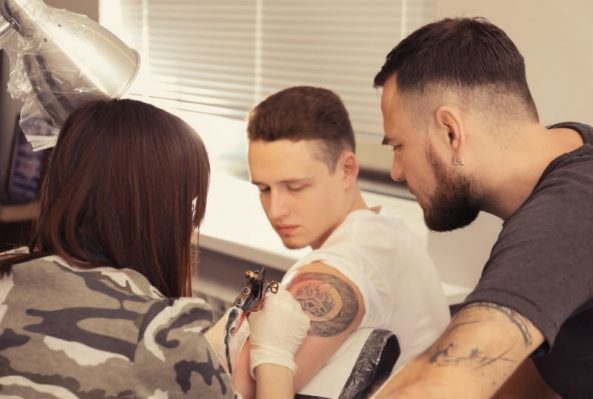
Find the right supervisor to learn from.
There’s a lot to study during an apprenticeship, but it’s a period when you can really hone your skills and figure out what it takes to become a professional.
Some programs requires you to pay, others don’t.
Here are some important tips for your apprenticeship:
- Find a shop or artist who is willing to train you.
- Instead of sending an email, come visit the shop, so that you can introduce yourself directly. This is also a good opportunity for you to let them see your portfolio.
- Find out if the program is paid or free. Some programs don’t cost any money, but you won’t be paid in exchange for the free education. If you need money to make ends meet, then the only solution is to look for a side job.
- In case a program requires you to pay, know that it could cost somewhere between $5,000 and $10,000.
- Sign a contract especially if it’s a paid program. Things should be stated clearly on the contract, including fees, skills they will be teaching you, responsibilities, etc.
- Be willing to listen and learn from your supervisor. A good supervisor is someone who knows how to mentor. Many of them have been in your shoes before, so they should know how to treat an apprentice right and give him the advice he needs.
- Get to know the basics of tattooing.
- Challenge yourself with more intricate designs.
Choosing an apprenticeship is a big deal because it makes a difference to your skill.
If you’re trained by someone who has had years of experience in this field, he can pass his knowledge down to you.
The problem is, who doesn’t want work with a well-known mentor?
If your target is a famous tattoo artist, be prepared to compete with other applicants.
Depending on where you do an apprenticeship, it can take few months to two years or more to finish it.
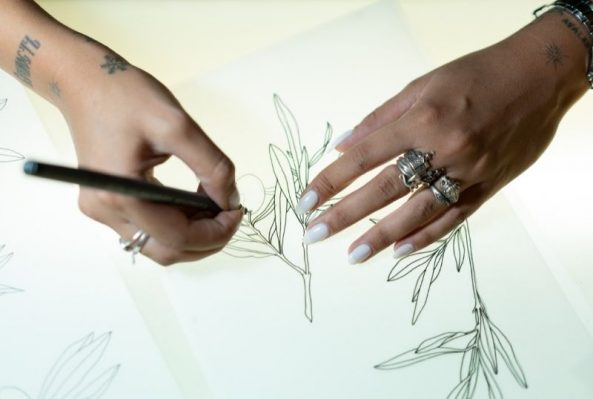
Make an Interesting Portfolio
A portfolio should be a resume of work that you consider the most favorable.
Buy a big folder to keep all the designs you’ve created.
The portfolio will grow as you do, so choosing a small folder is a mistake to avoid.
As for the hard cover, it should be made of a material that’s tough and can protect the pages below it.
You can also adorn it with a lot of details as it will affect the first impression.
In creating designs, utilize different mediums to show your versatility.
If you’re good at using pencils already, try drawing with watercolors, chalks, and other tools.
They all have unique textures and offer different experiences.
Furthermore, you should also create different objects.
It’s understandable when an artist is more inclined towards certain objects, like human faces or anime characters, but you have to remember that clients will have a final say on designs.
If you aren’t skilled enough to draw certain objects or forms, it can hamper your job as a tattoo artist.
There are a lot of ideas to try, such as flowers, animals, foods, fruits, mythological creatures, symbols, etc.
By the way, it’s important that the portfolio represents the style you’re interested in.
The following styles are popular with tattoo lovers:
1. Traditional Style
These tattoos are adored because they stand the test of time.
We believe many of the tattoos you have seen belong to this category. They usually incorporate bold lines and bright colors.
This is also among the most popular tattoo styles ever. As the name suggests, it’s the epitome of classic and tradition.
There are various designs that can be approached this way, like animals, skulls, hearts, and much more.
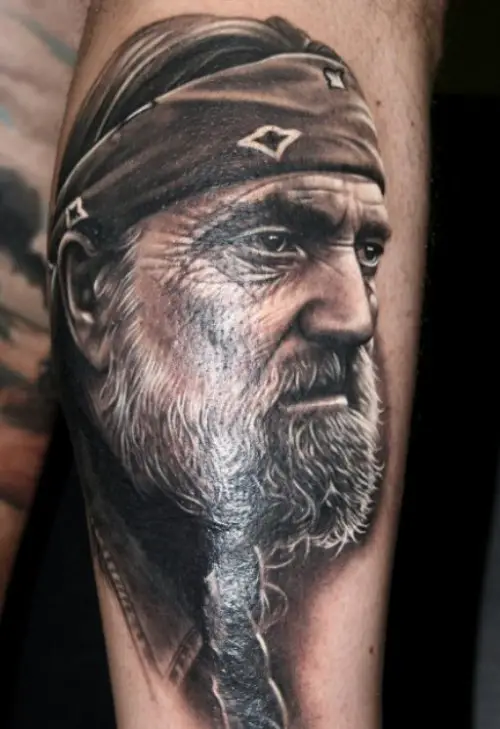
2. Realistic Style
A tattoo represented in this style looks like it could be a photograph.
It’s not easy to create a realistic tattoo because it requires keen observation and a good sense of perspective.
If it’s based on an actual object, you need to make it as accurate as possible.
For example, if it’s the face of a celebrity, you’ll need to create a tattoo that looks identical to that person.
An accurate depiction shows that you have great skills in this particular style.
3. Watercolor Style
This style is easily distinguishable from the watercolor-like appearance.
Although a watercolor tattoo looks rather simple, the application is not as easy as it might seem.
It still requires a high level of expertise to create this tattoo.
4. Tribal Tattoos
Tribal tattoos have been around for centuries, acknowledged by various cultures, including the Polynesians and Mayans.
These tattoos are known for having intricate patterns and meaningful messages.
Back in the day, tribal tattoos were used by tribes as a way to show affiliation within one another and establish ranks.
They still haven’t lost their meaning to this day, but many people get them for aesthetic reasons.
Tribal tattoos have unique characteristics, such as the use of black as the predominant color or a sole color.
They’re also focused on patterns that represent cultures where they originated from.
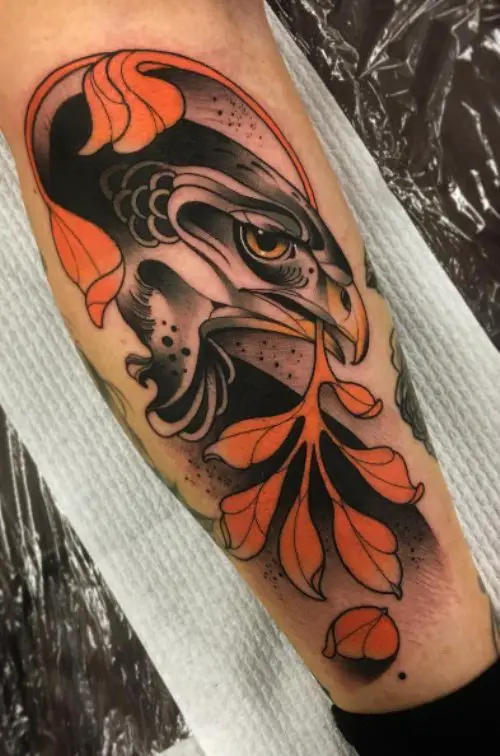
5. Neo-Traditional Style
Neo-traditional tattoos are a perfect blend of traditional features and modern grandeur.
They still have the traits of traditional tattoos, but there are specific elements that give them a new flavor.
For those who are fans of the timeless style yet want to incorporate vibrant colors and finer lines, neo-traditional tattoos are the way to go.
A portfolio should also display information on how you create a design.
If you draw inspiration from a picture, include it in the book.
If it’s an abstract, show the sketch from which it’s developed the final design.
It can give an insight on how you build up artwork and also reveal your strong points as an artist.
Get a License
After completing the apprenticeship, getting a license is the next logical step.
This is not always mandatory, though.
Some states and countries are stricter when it comes to tattoo regulations.
Others give more freedom to artists. For this reason, you should know the local laws regarding tattoo service.
If you’re required by law to get licensed prior to applying for a job or running a shop, then you should adhere to it.
Although regulations vary from state to state, there are things that you must be aware of as a professional tattoo artist, such as safety practices.
For example, it’s important to receive training on bloodborne pathogens to minimize the risk of exposure.
They are crucial especially for people who work in the medical field.
Although tattooing has nothing to do with healthcare, this procedure causes bleeding.
As we know, blood is a risk factor for transmission of various diseases.
You can ask your supervisor about tattoo licensing in your area.
Buy Tattoo Supplies
If you just got your feet wet in this business, there are a lot of supplies that you need to buy.
Tattoo equipment contributes a lot to your tattoo work, so choose carefully.
Here are some of the essential supplies:
1. Tattoo Machines
For an aspiring artist, knowing the different types of machines and finding the right ones to work with is very important.
There are two main types, rotary and coil machines.
Rotary machines are the newer trend.
They offer many advantages, like lower noise outputs and awesome versatility. Besides, they are also very lightweight.
Coil machines are the more traditional type.
Despite the fact that these machines make so much noise, they are very reliable and work extremely great for lining and shading.
The differentiating feature is coils, which contribute to the hitting power.
The more wraps a machine has, the more powerful it will be.
Coil machines come in two varieties, liners and shaders.
Familiarize yourself with both because they have a lot in common, but are still different when viewed up close.
2. Tattoo Ink
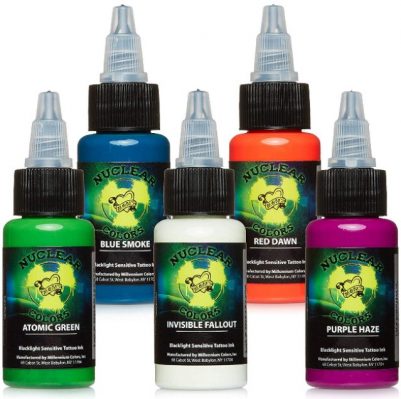
Tattoo ink is another integral part of tattooing.
In fact, it holds more importance than machines because it will be injected into the skin and remain there until the immune system breaks up the particles and flushes them away.
Don’t be afraid to invest in quality ink. It may be costly, but it will benefit you more in the long run.
Remember that high quality ink has quality to back it up.
It’s free of harmful and harsh chemicals, meaning it’s safe for skin application.
There are many reputable tattoo ink brands out here, like Millennium Mom’s, Kuro Sumi, Intenze, and Starbrite.
Each one has a different lineup of products.
Aside from quality, colors are also important to consider.
If your favorite brand doesn’t have the shades you’re looking for, check out other brands.
3. Tattoo Needles
Tattooing has to take place in a sterile environment, so it should also involve sterile equipment.
Besides wearing safety gloves to minimize the risk of exposure, you should also use sterile needles because they come in direct contact with the skin.
Poor safety practices are alarming because their put clients’ health at jeopardy.
Tattoo needles are described using codes, which can provide information about their groupings or configurations.
Next, check on the expiration date before you start a new procedure. Make sure the needles are in good shape.
Disposable needles are usually packaged into pre-sterilized individual blister packs for the best safety.
4. Tattoo Power Supply
We rarely give power supplies much attention, but they matter just as much.
Without a reliable power supply, you will have trouble operating your machines.
Hence, take time to pick the best power supply. It needs to be compatible with the devices you use for tattooing.
It should also work with different types of machines, such as liners and shaders.
Additionally, learn about the voltage output range as it has an impact on power.
The higher the output, the more power it can generate.
In case you don’t want to waste time shopping around for a power supply, the best suggestion is to buy a kit because all items in a kit are designed to be compatible with each other.
There shouldn’t be compatibility issues with the foot pedal, power cord, and other items that come with the package.
5. Tattoo Gloves
Gloves are also essential as they create a protective barrier between a tattoo artist and a client.
Although you have cleaned everything properly, it doesn’t give you an excuse to not wear gloves during a tattoo session.
Contact with body fluids can still happen throughout the process.
Wearing safety gloves isn’t just for you, but also for your clients.
High standards of hygiene are necessary to protect both sides the best way possible.
Tattoo gloves are made of a variety of materials, such as nitrile, latex, and vinyl.
They all have pros and cons, so get to know them better before making a purchase.
Those were some of the most common supplies for tattooing.
There are many others that may be included in a kit, such as grommets, tips, rubber bands, practice skin, and o-rings.
Find a Job
This is the next crucial step after finishing an apprenticeship.
You did everything to get a job, right?
The thing is the tattoo industry is highly competitive. It could be hard to get a job if you’re at the beginning of your career.
But don’t give up, as your portfolio grows, it will open the door for more opportunities.
Just keep looking for job openings on any job-hunting platforms. Also, see if any tattoo parlors around you are hiring.
Even if you can’t get a job in a conventional way, you can still offer your skills directly.
The demand for tattoos has grown steadily in recent years. It’s also easier to connect with people thanks to the advent of social media.
You just need to be more active in promoting your work in order to attract potential clients.
All in all, being an independent tattoo artist isn’t a bad thing.
Open a Tattoo Shop
If working at a parlor isn’t an option or you simply need freedom, then opening a tattoo shop is a good idea.
However, this requires a lot of preparation. It should start by selecting a location, understanding the local laws, and then raising capital to fund the business.
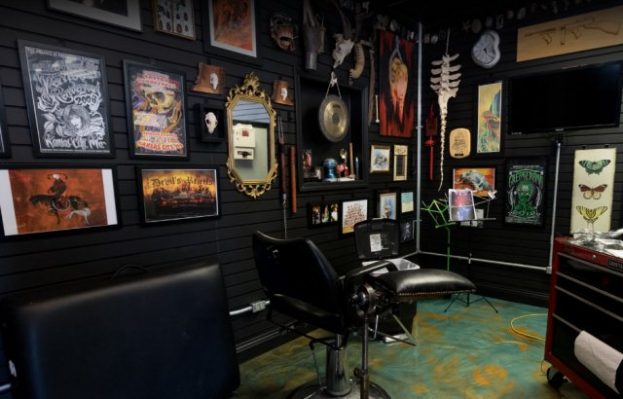
1. Finding a Location
It takes time to find a location that fits your criteria.
The shop should be situated at a strategic place where people gather around, so they can see it.
The visibility will affect people’s interest.
If the shop is located in a secluded area, nobody will waste time to visit unless you already have a reputation to begin with.
Besides location, the size of the shop also matters. It should be large enough to accommodate all workers and customers.
And think of the equipment that you’ll add to the shop.
There should be enough space for them all.
There’s no problem with a small shop, but this is assuming that you have a small customer base.
As you build your clientele, more space will be needed to accommodate them.
Customer satisfaction is critical for every business and inextricably linked to loyalty.
Hence, you should thrill them with good hospitality and top-tier service.
2. Buying Supplies
Running a tattoo shop isn’t something you can do with a limited budget.
Part of the budget will go into buying tattoo supplies.
For the record, tattoo supplies come in different grades, namely low, medium, and high grades.
It’s all up to you to decide what kind of supplies you want for the shop.
You need to buy stencil transfer paper and a thermal copier machine to create designs.
You should also allocate the budget for tattoo machines.
Each artist you employ should be equipped with at least a pair of shader and liner.
Given that shaders and liners have different jobs, they should come together, not replacing each other.
Ink and needles are other essential supplies.
They have an impact on safety, so make sure to invest in quality products, so that you don’t have to worry about hygiene.
3. Follow Safety Practices
Tattooing has some risks that shouldn’t be taken lightly.
This procedure injects ink into the skin.
If there’s something wrong with the ink and other equipment used for tattooing, it can cause health concerns.
Infection may occur due to the use of unsterile needles. Allergic reactions are also a possibility.
They can happen when someone can’t tolerate the ingredients in the ink.
You should know these risks and how to deal with them correctly. S
peaking of safety practices, there are a few points to remember.
First, use disposable equipment as much as possible.
Disposable needles are usually pre-sterilized with gamma radiation or another advanced method. Besides, they come in individual sterile packages.
To further assure proper sterilization, an autoclave is also necessary.
This machine sterilizes equipment using steam at high heat and pressure.
Meanwhile, disinfectant solutions can boost hygiene by killing germs and bacteria.
As for the tattoo artist, wearing gloves is important to prevent exposure to contaminants.
And since tattooing uses ink a lot, gloves will be effective to prevent staining.
Final Thoughts: Becoming a Tattoo Artist
Well, there you have it.
Now you know how to become a Tattoo Artist.
Hopefully this article will help you understand the paths, and help you make an informed decision.
Good luck in your career endeavor of becoming a professional Tattoo Artist!
